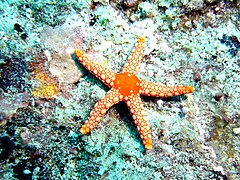
Starfish or sea stars are star-shaped echinoderms belonging to the class Asteroidea. Common usage frequently finds these names being also applied to ophiuroids, which are correctly referred to as brittle stars or basket stars. Starfish are also known as asteroids due to being in the class Asteroidea. About 1,900 species of starfish live on the seabed in all the world's oceans, from warm, tropical zones to frigid, polar regions. They are found from the intertidal zone down to abyssal depths, at 6,000 m (20,000 ft) below the surface.

The Echinasteridae are a family of starfish in the monotypic order Spinulosida. The family includes eight genera and about 133 species found on the seabed in various habitats around the world.
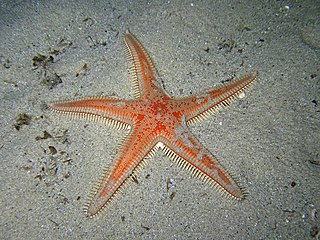
Astropecten aranciacus, the red comb star, is a sea star of the family Astropectinidae. It is native to the east Atlantic Ocean and the Mediterranean Sea.
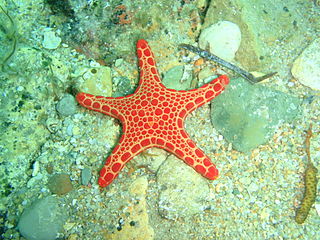
Goniasteridae constitute the largest family of sea stars, included in the order Valvatida. They are mostly deep-dwelling species, but the family also include several colorful shallow tropical species.

The common sunstar is a species of sea star belonging to the family Solasteridae. It is found in the northern parts of both the Atlantic and the Pacific Oceans.

Ophiura ophiura or the serpent star is a species of brittle star in the order Ophiurida. It is typically found on coastal seabeds around northwestern Europe.

Astropecten irregularis is a sea star of the family Astropectinidae. Common names include Sand sea star.

Astropecten bispinosus is a sea star of the family Astropectinidae from the Mediterranean Sea.

Astropecten spinulosus is a sea star of the family Astropectinidae.
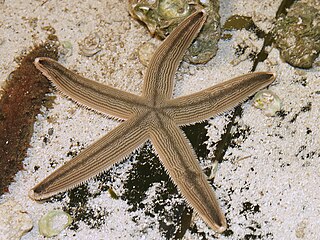
Luidia clathrata is a tropical species of starfish in the family Luidiidae. It is variously known as the slender-armed starfish, the gray sea star, or the lined sea star. It is found in the western Atlantic Ocean.
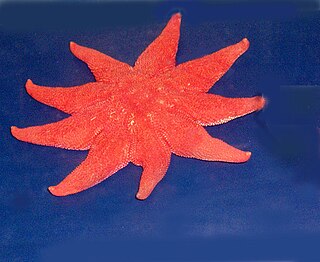
The purple sunstar, northern sunstar, or smooth sun star, Solaster endeca, is a species of starfish in the family Solasteridae.
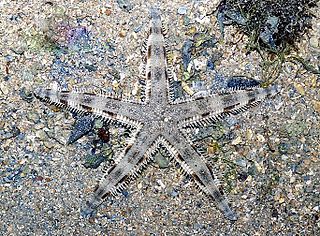
Archaster typicus is a species of starfish in the family Archasteridae. It is commonly known as the sand star or the sand sifting star but these names are also applied to starfish in the genus Astropecten. It is found in shallow waters in the Indo-Pacific region.

Luidia senegalensis, the nine-armed sea star, is a tropical species of starfish in the family Luidiidae found in the western Atlantic Ocean.

Luidia foliolata, the sand star, is a species of starfish in the family Luidiidae found in the northeastern Pacific Ocean on sandy and muddy seabeds at depths to about 600 m (2,000 ft).
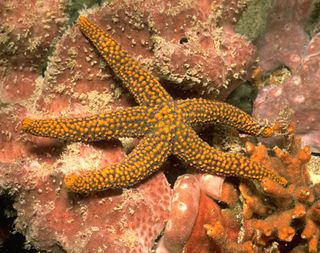
Echinaster spinulosus, the small spine sea star, is a species of sea star found in shallow parts of the western Atlantic Ocean, the Caribbean Sea and Gulf of Mexico.
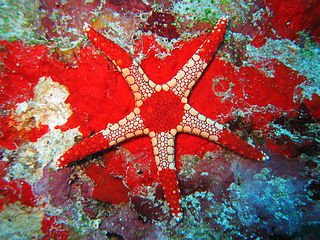
Fromia monilis, common name necklace starfish or tiled starfish, is a species of starfish belonging to the family Goniasteridae.

Fromia is a genus of starfish belonging to the family Goniasteridae.

Ophiura albida is a species of brittle star in the order Ophiurida. It is typically found on the seabed in the north eastern Atlantic Ocean and in the Mediterranean Sea and is sometimes known as the serpent's table brittle star.
Trophodiscus almus is a species of starfish in the family Astropectinidae. It is found in fairly deep waters in the Sea of Okhotsk, the Sea of Japan and around the Japanese island of Hokkaido. It is very unusual among starfish in that it broods its young on its upper surface. Its common name in Japanese is "Komochi-momiji".

Echinaster callosus, the warty sea star or the banded bubble star, is a species of starfish found in shallow parts of the western Indo-Pacific region. The disc and five slender arms are covered with white, pink, red or violet warts, often forming transverse bands of colour on the arms.

